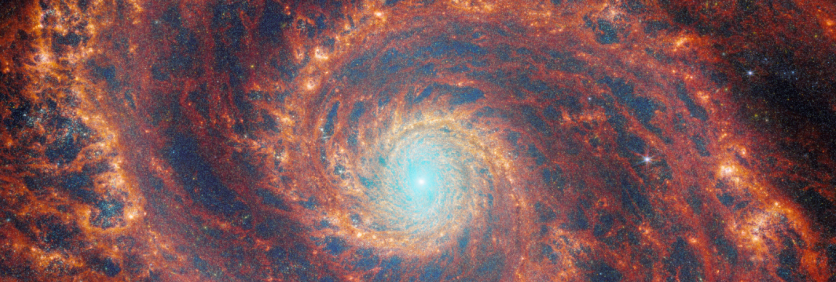The James Webb Space Telescope, a collaborative effort between NASA, ESA, and CSA, has revealed a captivating image of the grand-design spiral galaxy M51, the Whirlpool Galaxy.

Gracefully Winding Arms
In this stunning image, the gracefully winding arms of the galaxy, adorned with prominent, well-defined spiral arms, are on full display. Unlike the myriad of peculiar spiral galaxies characterized by irregular or disrupted arms, grand-design spiral galaxies possess these pronounced features.
This visual masterpiece is a composite image created by combining data collected by Webb's Near-InfraRed Camera (NIRCam) and the Mid-InfraRed Instrument (MIRI). Notably, the European Space Agency (ESA) contributed half of the data from MIRI.
The composite image artfully showcases the filamentary warm dust interwoven within the galaxy's medium. Dark red regions trace this warm dust, while red hues illuminate the reprocessed light resulting from complex molecules forming on dust grains.
Shades of orange and yellow unveil regions of ionized gas brought about by recently formed star clusters. The galaxy's medium is shaped by stellar feedback, producing a complex network of luminous knots and dark voids.
M51, situated approximately 27 million light-years away in the constellation Canes Venatici, is also engaged in a dynamic interaction with its neighboring dwarf galaxy, NGC 5195.
This interaction has rendered M51 and NGC 5195 one of the more extensively studied galaxy pairs in the celestial sphere. M51's distinctive and prominent spiral arms owe their stately nature, in part, to the gravitational influence of its smaller companion.
Stellar Feedback
This observation of M51 is part of a series called Feedback in Emerging Extragalactic Star clusTers (FEAST). FEAST aims to unravel the intricate interplay between stellar feedback and star formation beyond our Milky Way.
Stellar feedback describes the energy stars release into their surrounding environments during their formation, significantly influencing the rate of star formation. Comprehending this process is pivotal for constructing accurate models of universal star formation, according to ESA.
FEAST's mission is to investigate and study stellar nurseries in galaxies outside of our own Milky Way. While previous observatories like the Atacama Large Millimetre Array and the Hubble Space Telescope provided glimpses of star formation at its onset or after stars have dissipated their natal gas and dust clouds, Webb offers a fresh perspective.
Webb unveils the early stages of star formation, the emission of stellar light, and the energy reprocessing of gas and dust. For the first time, scientists are observing star clusters emerging from their birth clouds in galaxies beyond our local group, providing insights into the formation of planets and brown dwarfs.
As dust and gas are depleted from newly formed stars, the material required for planet formation diminishes. Webb's observations allow scientists to measure the duration it takes stars to enrich themselves with newly formed metals and cleanse the surrounding gas.
Related Article : NASA's Webb Spots Massive Plume from Saturn Moon Spanning Nearly the Distance from LA to Buenos Aires

ⓒ 2025 TECHTIMES.com All rights reserved. Do not reproduce without permission.




